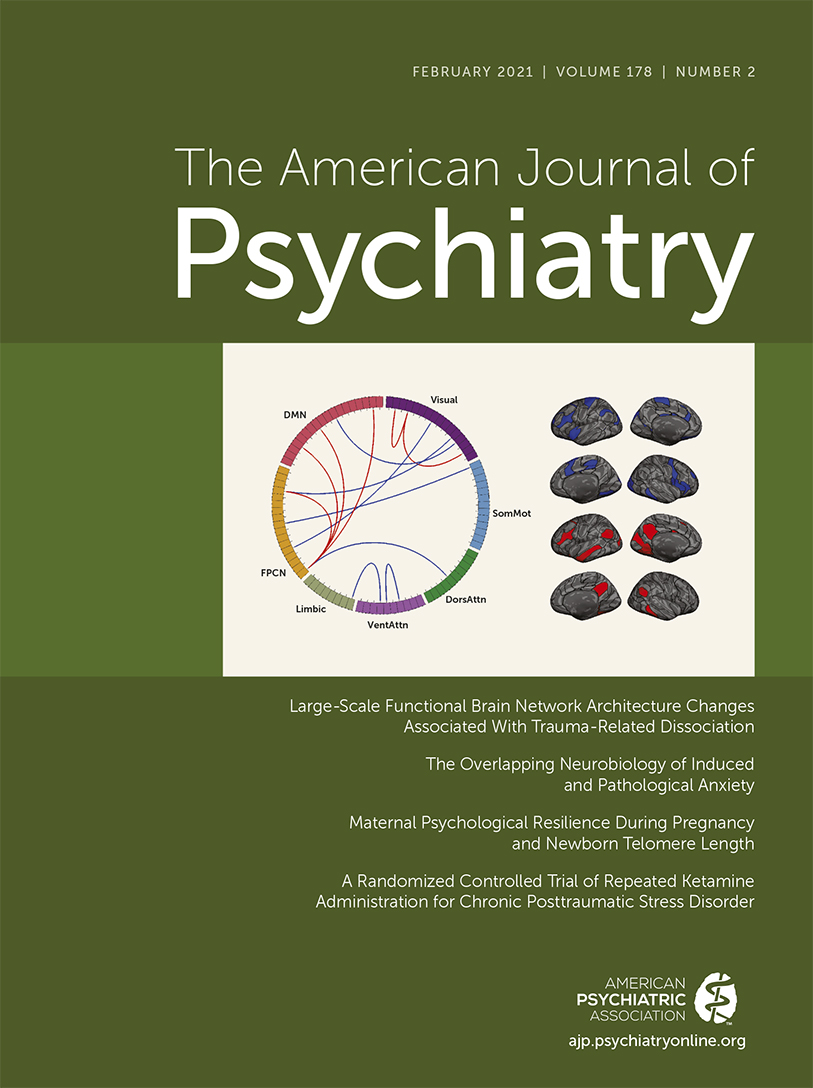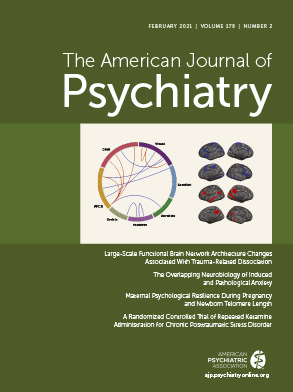Posttraumatic stress disorder (PTSD) is a devastating mental illness that can follow exposure to life-threatening stress. Although several psychological treatments for PTSD have proven efficacy (
1), their dissemination has yet to be widespread, owing in part to their complexity and requirement for expert practitioner training. Furthermore, trauma-focused exposure-based psychotherapies can be quite challenging for patients with PTSD, initially triggering heightened arousal and avoidance that can result in treatment dropout prior to achieving therapeutic benefits. Pharmacotherapeutic options for PTSD have been even more limited in their demonstrated utility, with only two drugs, paroxetine and sertraline, both selective serotonin reuptake inhibitors (SSRIs), approved by the Food and Drug Administration (FDA) for the treatment of PTSD two decades ago (and venlafaxine extended-release showing efficacy but not submitted for FDA approval). These agents also commonly cause side effects before therapeutic effects, contributing to early discontinuation. Whereas many other drugs have been studied for PTSD over the ensuing years (
2), none have garnered incontrovertible evidence of efficacy, although several—including prazosin and atypical antipsychotics such as quetiapine and risperidone—have had their successes (
3,
4) and failures (
5,
6). This disappointing state of affairs has led to calls for a prioritization of efforts to find new treatment approaches and in particular novel targets and agents for drug development for PTSD (
7).
There was a time when many of us opted to use the term “pharmacological agents” rather than the colloquial and negatively tinged “drugs” when referring to medication treatments for mental disorders. In the past few years, such semantic distinctions may have become blurred, as many of the novel pharmacological agents being studied for PTSD (and depression) are, indeed, drugs. MDMA (“ecstasy”), psilocybin (“magic mushrooms”), and ketamine (“Special K”) represent the cutting edge of psychiatry’s (re)enchantment with psychedelic drugs for our patients who suffer from the chronic effects of traumatic stress (
8,
9). The renaissance of these vintage psychoactive agents is highlighting our field’s struggles to identify and develop potent, novel pharmaceuticals. We have much to learn about the complex and interactive neural systems that drive psychopathology and treatment response in complex disorders such as PTSD.
In this issue of the
Journal, Adriana Feder, M.D., and colleagues (
10) present results of their important trial of repeated intravenous ketamine administration for patients with PTSD. This article, a follow-up to their study of single-dose ketamine for PTSD (
11), makes a compelling argument that repeated dosing of ketamine may eventually have a role to play in the battle against PTSD. This small study demonstrated clear superiority of six intravenous infusions of ketamine compared with midazolam (a psychoactive control) over 2 weeks, with two-thirds of patients considered responders to ketamine compared with one-fifth of those receiving midazolam. In a rarity for mental health studies, the trial was stopped early (with 30 patients enrolled, rather than the preplanned 40 patients) when an interim analysis revealed that ketamine had an insurmountable lead over midazolam. While response (defined as 30% reduction in symptoms) does not represent remission and durability was still limited with a median time to relapse of 27.5 days, these are nonetheless both rapid and robust effects, suggesting that intravenous (and perhaps other delivery methods for) ketamine has tremendous potential as a treatment for PTSD. This conclusion leads to many questions such as “how” and “why.”
Ketamine is an
N-methyl-
d-aspartate receptor antagonist, although it is still uncertain whether its actions at that receptor mediate its antidepressant, and now anti-PTSD, effects. Considering the strong polygenic association of major depressive disorder and PTSD (
12), one might expect there to be considerable overlap in therapeutics. Given that it has also been shown, in preliminary studies, to relieve symptoms of social anxiety disorder (
13) and obsessive-compulsive disorder (
14), it might be tempting to muse about the pan-diagnostic therapeutic or proresiliency effects of ketamine, which may well be true descriptively but contributes naught to understanding mechanism of action. Similarly, whereas it might seem attractive to test hypotheses about glutamatergic dysfunction underlying the pathophysiology of ketamine-responsive disorders, decades of work trying to link SSRI-responsivity to mental disorder biology have yet to prove informative. That said, it will be critically important to gain insight into ketamine’s mechanisms of action—and we use the plural deliberately—with an open mind to the possibility that different properties of the drug may mediate efficacy for different disorders.
Another open question for ketamine and other psychedelic agents of its class is whether concomitant psychotherapy yields a greater and more durable treatment response. Research in ketamine-assisted psychotherapy and its optimal application for PTSD is needed, including pairing with evidence-based trauma-focused therapies as the authors and others suggest (
15). It is worth noting that this study applies the more medical model of ketamine use with an aim to function as an independent therapeutic. Nonetheless, it cannot be ruled out that ketamine—which has comparable effects on induction of a subset of psychedelic experiences as psilocybin and LSD—might be most durable in its effects if it is followed by psychotherapy (
15). Ketamine’s postulated mechanistic properties that enhance neural plasticity may set the stage for greater receptivity to psychotherapeutic engagement and efficacy. Indeed, it is notable that Feder and colleagues found the greatest PTSD symptom reduction at 2 weeks in the subcategory of avoidance, which commonly is more resistant to rapid change in PTSD.
But with effects as large and impressive as seen in this study, one could be forgiven for wanting to jump ahead from the “how does it work” to the “when can we start using it” stage of mental health practitioner inquiry. The number needed to treat in this study was a remarkable 2, the treatment was well tolerated, and ketamine is already being widely used—either off-label intravenously or intramuscularly, or as the FDA-approved intranasal esketamine for treatment-resistant depression or depression with acute suicidality with intent—so extending its use to PTSD could be seen as both obvious and imperative.
However, as Feder and colleagues wisely counsel, there is still much work to be done before ketamine is ready for prime time in the treatment of PTSD. A total of 15 patients were exposed to repeated intravenous ketamine in this study; small, expertly executed trials such as this one are great for providing an impetus to study the treatment in larger samples, where response and tolerability will inevitably be less uniform. It is also important to remember that whereas ketamine and esketamine are filling a void in the management of treatment-resistant depression, patients in this PTSD study were not enrolled because they had treatment-resistant PTSD (which, at present, has no widely accepted definition). That said, half of the patients in this trial had histories of exposure to sexual assault or molestation—trauma types that might be expected to be more treatment-resistant than some others—and approximately half were symptomatic enough to enter the trial despite receiving another pharmacotherapy and/or psychotherapy, yet response was robust. This observation bodes well for ketamine (or esketamine) eventually assuming an important role in the management of treatment-resistant PTSD. But the work needs to be done to establish that therapeutic positioning.
Lastly, how worried should we be about the use of ketamine, a drug that can be abused, in a disorder such as PTSD that is strongly associated with increased drug and alcohol dependence (
16)? This study purposefully excluded those with use disorders in the past 3 months. To answer this question, we must take into account that ketamine is also being used to treat substance use disorders, buttressed by animal and human studies suggesting that ketamine may pharmacologically “rewrite maladaptive memories” (
17), a rather Orwellian albeit apt phrasing. To achieve this effect, the assumption is that ketamine, when paired with maladaptive memories (substitute “traumatic memories” for the PTSD use case), disrupts their reconsolidation, thereby weakening or ablating those memories. In this study with intravenous ketamine, there was no deliberate pairing of recall of the traumatic memories with the administration of the drug, and yet symptoms improved. Was it the case, then, that patients were thinking about their traumas when the drug was present, and that this adventitious pairing was sufficient for ketamine to have its rapid effects? If true, is it possible that more deliberate recall of the trauma at the time of ketamine administration would result in even stronger (and, possibly, longer-lasting) effects? This is a testable premise that, if upheld, would make ketamine for PTSD that much more special.

